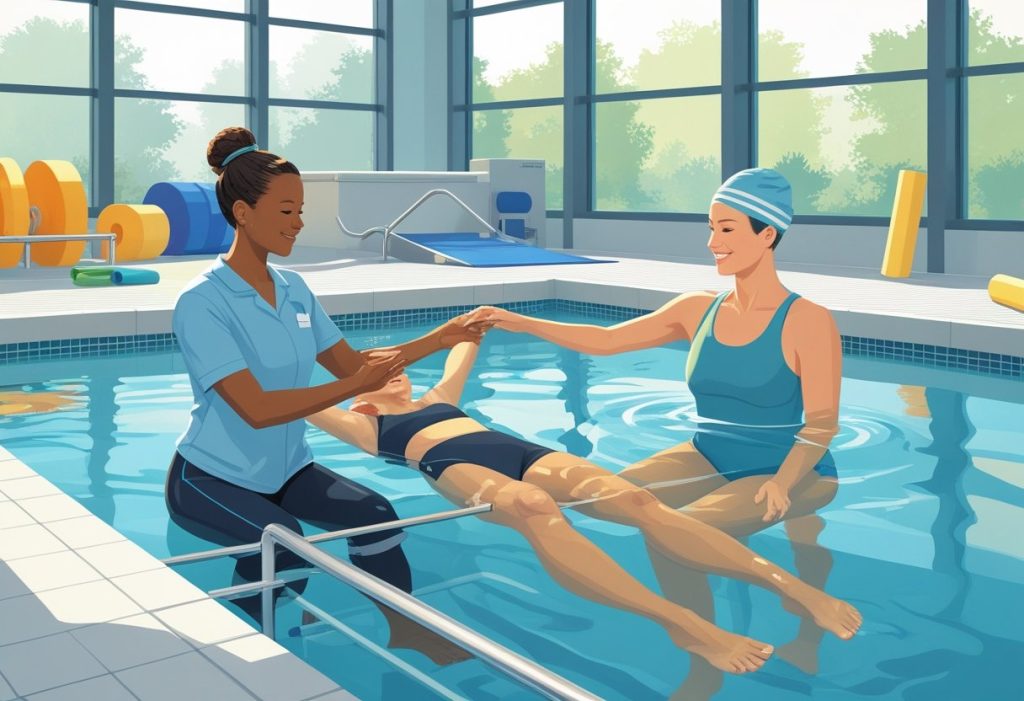Aquatic physical therapy is an effective rehabilitation method that uses the properties of water to enhance recovery and improve physical function. This type of therapy offers a low-impact environment, making it ideal for those with injuries, chronic pain, or mobility challenges. By incorporating exercises in water, you can benefit from buoyancy, which reduces strain on your joints while providing resistance to build strength and endurance.
As you engage in aquatic therapy, you may experience improved range of motion and decreased pain, allowing for greater functional mobility. Many facilities, including options like Spaulding Rehabilitation, tailor programs specifically for individual needs, ensuring optimal outcomes. Additionally, working with certified professionals ensures you receive effective treatment for your unique circumstances.
When considering Medicare insurance options for your therapy needs, The Modern Medicare Agency stands out as a reliable choice. Our licensed agents prioritize your needs and can guide you in selecting Medicare packages that align with your requirements. With personalized support, you can access the care you need without worrying about extra fees.
What Is Aquatic Physical Therapy?
Aquatic physical therapy, also known as hydrotherapy or aqua therapy, uses water to facilitate exercise and rehabilitation. It leverages unique properties of water, such as buoyancy and hydrostatic pressure, making it beneficial for various physical therapy applications.
Definition and Core Principles
Aquatic physical therapy is a specialized form of rehabilitation that takes place in a pool. It aims to enhance mobility, reduce pain, and improve overall function. The key principles include using buoyancy to alleviate weight-bearing stress, allowing for easier movement compared to traditional settings.
Additionally, hydrostatic pressure aids circulation, which can reduce swelling and pain. The natural resistance of water provides a safe environment for strengthening exercises, catering to individuals recovering from surgery, injury, or chronic conditions.
Therapists design programs tailored to your specific needs, enhancing your recovery process while promoting strength and flexibility.
Differences Between Aquatic Therapy and Traditional Physical Therapy
The primary distinction lies in the environment. Traditional physical therapy often occurs on solid ground, relying on gravity, while aquatic therapy harnesses the properties of water for healing.
In aquatic therapy, buoyancy reduces the impact on joints, making movements less painful. This benefit is particularly essential for individuals with arthritis or post-operative recovery.
Furthermore, the resistance water provides helps in strength training without the need for weights. Such aspects can lead to improved outcomes in range of motion and reduced rehabilitation time, as patients can perform activities they might struggle with on land.
Common Techniques and Methods
Several techniques characterize aquatic physical therapy, tailored to support your recovery goals. These include:
- Therapeutic exercises: Resistance training using water to build strength.
- Water walking: Enhancing mobility while minimizing joint stress.
- Aquatic stretches: Improving flexibility through supported movements.
Other methods include balance training and coordination exercises in water, creating a comprehensive rehabilitation approach. The engaging nature of these activities also encourages patient participation and enjoyment, making the therapy process more effective and motivating.
Choosing aquatic physical therapy can lead to a more comfortable recovery journey tailored to your needs. If you’re exploring options for Medicare insurance, The Modern Medicare Agency is here to help. Our licensed agents work one-on-one with you to find packages that meet your requirements without unnecessary fees.
Benefits of Aquatic Physical Therapy
Aquatic physical therapy offers unique advantages that promote healing and improve overall physical well-being. By utilizing the properties of water, this therapy effectively addresses multiple aspects such as pain relief, strength enhancement, and mobility improvement.
Pain Relief and Relaxation
The buoyancy of water reduces stress on joints, providing significant pain relief for individuals with conditions like arthritis or chronic back pain. When submerged, your body experiences decreased body weight, which alleviates pressure on muscles and joints.
This environment also promotes relaxation, allowing for reduced muscle tension. The soothing nature of water can enhance circulation, improving blood flow throughout your body. As your muscles relax, you may notice a decrease in pain levels and an improvement in your overall sense of well-being.
Enhancing Strength and Endurance
Water provides natural resistance, allowing for effective strength training without the risk of injury associated with traditional weights. Adjusting the speed of your movements can increase the intensity, promoting muscle strength and endurance.
Incorporating various exercises, such as aqua jogging or resistance band workouts, can help build muscle while improving cardiovascular conditioning. This dual focus enhances your stamina and supports better performance in daily activities as well as other exercises on land.
Improving Mobility and Flexibility
Aquatic therapy facilitates movements that may be difficult on land, promoting greater range of motion. The water’s support allows you to stretch and strengthen muscles without the fear of falling or straining.
Flexibility exercises in water can lead to improved mobility. By regularly engaging in these sessions, you may experience a noticeable increase in your ability to perform everyday tasks with ease, which contributes to a more active and fulfilling lifestyle.
Boosting Balance and Coordination
Water creates a unique environment for balance training. The resistance it offers forces your body to engage stabilizing muscles, improving both balance and coordination.
By practicing exercises specifically designed to enhance stability while submerged, you can develop a stronger foundation. This improved balance not only benefits physical activities but also reduces the risk of falls, making it especially valuable for older adults or those recovering from injury.
For comprehensive support in navigating Medicare insurance options, consider The Modern Medicare Agency. Our licensed agents are dedicated to providing personalized assistance and identifying the best packages for your needs, without hidden fees.
Medical Conditions Treated With Aquatic Therapy
Aquatic therapy can effectively address a variety of medical conditions, providing relief and enhanced mobility. This therapy is particularly beneficial for individuals with orthopedic, neurological, and chronic conditions, as well as for pediatric and geriatric populations.
Orthopedic and Musculoskeletal Disorders
Aquatic therapy is widely used for orthopedic and musculoskeletal disorders. Conditions such as arthritis (including osteoarthritis and rheumatoid arthritis) benefit significantly from the buoyancy of water, which reduces joint stress during movement.
Individuals suffering from back pain and scoliosis experience increased flexibility and strength, which can alleviate discomfort. In addition, those recovering from joint replacement surgeries find the supportive environment conducive to rehabilitation.
Sprains and strains can also be treated effectively, as water can facilitate gentle exercises that promote healing while minimizing pain.
Neurological and Chronic Conditions
Aquatic therapy provides unique advantages for managing neurological conditions. For patients with multiple sclerosis, the warmth of the water can help decrease muscle stiffness, aiding in mobility.
Individuals recovering from a stroke often find aquatic therapy essential for regaining strength and coordination. The water environment encourages safe movement, enabling progress at a manageable pace.
Parkinson’s disease patients can benefit from enhanced balance and coordination exercises in the water, which facilitate functional improvements. Furthermore, those with chronic pain conditions like fibromyalgia experience relief through gentle, low-impact movement that reduces pain and increases endurance.
Pediatric and Geriatric Applications
Within pediatric populations, aquatic therapy can support children with autism or developmental delays by improving motor skills and providing sensory integration opportunities. The aquatic setting often feels less intimidating, encouraging participation.
For elderly individuals, particularly those with osteoporosis, aquatic therapy offers a safe and effective means of strengthening muscles while reducing the risk of falls. The support from water allows for greater range of motion, which can be instrumental in maintaining independence.
Both age groups benefit from customized exercises that enhance balance and coordination, reducing the incidence of injuries associated with falls.
Core Techniques and Exercise Modalities
Aquatic physical therapy employs various techniques that focus on rehabilitation through water-based exercises. The methodologies enhance strengthening, improve posture, and increase the range of motion while minimizing the risk of falling.
Aquatic Strengthening and Conditioning
Aquatic strengthening utilizes the resistance of water to build muscle without stressing your joints. Exercises such as water squats, leg lifts, and resistance band workouts target specific muscle groups.
- Benefits: Improved muscle strength, increased endurance, and enhanced overall conditioning.
- How It Works: Water’s buoyancy helps support your body, allowing you to perform exercises with less strain, which is essential for individuals with muscle spasms or joint issues.
Target your overall strength by incorporating movements like push-ups against the pool wall and core engagements through seated leg lifts in water. These exercises facilitate muscle development while addressing rehabilitation needs.
Gait Training and Walking Exercises
Gait training in a pool setting allows you to improve your walking mechanics effectively. Water provides an ideal environment for practicing balance and posture.
- Benefits: Enhanced gait pattern, reduced risk of falls, and improved cardiovascular fitness.
- How It Works: The water’s resistance challenges your strength while buoyancy eases stress on your legs.
You might perform walking drills that incorporate forward and lateral movements, focusing on maintaining a steady pace. This approach helps you refine your steps and correct posture, vital for those recovering from an injury.
Balance and Flexibility Routines
Aquatic therapy also emphasizes balance and flexibility, which are critical for stability. Exercises targeting these areas can significantly reduce the risk of falling.
- Benefits: Greater range of motion, enhanced flexibility, and improved balance.
- How It Works: Water helps support your movements, making it easier to stretch and engage in various positions.
Utilize tools like foam noodles or balance boards within the water for effective stretching routines. Incorporate exercises that promote rotational movements and side bends to enhance flexibility.
Your commitment to these aquatic techniques can lead to substantial improvements in your rehabilitation journey while making daily activities more manageable. For your Medicare Insurance needs, consider The Modern Medicare Agency for personalized support.
Safety, Preparation, and Professional Guidance
Ensuring safety and proper preparation is crucial for a successful aquatic physical therapy experience. This section focuses on who should avoid therapy, the role of professionals, facility readiness, and how to prepare for your sessions.
Who Should Avoid Aquatic Physical Therapy?
Certain individuals may need to avoid aquatic physical therapy due to specific health concerns. If you have open wounds, a fever, or infectious diseases like hepatitis, participation may pose risks.
Those with uncontrolled seizure disorders or severe incontinence should also consider alternatives. Compromised blood pressure levels can indicate the need for caution. It’s essential to consult your healthcare provider to assess your condition before starting therapy. Your safety is the priority, so don’t hesitate to voice concerns.
Role of the Physical Therapist and Clinicians
A qualified physical therapist is essential for effective aquatic therapy. They assess your medical history and tailor a program to your individual needs. This personalized plan considers any health restrictions you might have.
Physical therapist assistants also play a vital role in executing the treatment plan and ensuring your comfort. Clinicians should be involved in ongoing assessments to track your progress, allowing adjustments to the therapy as necessary. Communication between you and your healthcare team is key.
Facility Preparation and Equipment
Proper facility preparation and equipment usage are critical for a safe environment. Ensure the location is equipped with appropriate safety features such as railings and non-slip surfaces.
Pools should be sanitized with chlorine; however, verify that chemical levels are safe for sensitive skin. Lockers and shower facilities help maintain hygiene. Confirm the availability of towels and cover-ups to help you feel comfortable before and after your sessions.
Preparing for Treatment Sessions
Preparation enhances your overall experience in aquatic therapy. Wear a swimsuit that allows freedom of movement and is appropriate for the setting. When you arrive, take time to shower and wash off any products that may irritate the pool environment.
If you have anxiety related to water, consider bringing a caregiver for support. Discuss any concerns with your physical therapist beforehand. Clear communication can set realistic expectations and alleviate apprehensions. Being well-prepared contributes to a productive and positive therapy experience.
Aquatic Physical Therapy Approaches and Methods
Aquatic physical therapy employs various methods to enhance recovery and improve fitness levels. These approaches leverage the physical properties of water, such as buoyancy and warmth, to aid in rehabilitation while making sessions enjoyable.
Halliwick Concept
The Halliwick Concept is a method focused on promoting independence in water. It uses a variety of activities and exercises tailored to each individual’s abilities.
Key features of this approach include:
- Therapeutic Activities: Engaging movements that build confidence and promote relaxation.
- Gradual Progression: Activities are designed to match your skill level and comfort.
- Mental Focus: Emphasizes cognitive awareness and control over body movements.
This method helps reduce stress and tension, allowing for a supportive environment conducive to rehabilitation.
Bad Ragaz Ring Method
The Bad Ragaz Ring Method utilizes resistance from the water for therapeutic purposes. Practitioners use floating rings to assist in therapeutic exercises.
Key aspects include:
- Resistance Training: Water provides natural resistance, enhancing strength and flexibility.
- Customized Programs: Treatment sessions are adapted to individual goals within your plan of care.
- Warm Water Therapy: The warmth of the water promotes comfort, alleviating symptoms of inflammation and enhancing relaxation.
This method is effective for various conditions, enhancing overall function and quality of life.
Watsu and Relaxation Therapies
Watsu combines elements of water healing and massage techniques. This method is particularly effective for stress relief and muscle relaxation.
Essential components include:
- Floating Techniques: You are gently floated and supported, promoting deep relaxation.
- Massage Elements: Incorporates stretching and rhythmic movements that relieve tension.
- Mind-Body Connection: Focuses on deep breathing and mental relaxation, improving overall well-being.
These relaxation therapies can play a significant role in recovery, easing both physical and emotional stresses.
Underwater Treadmill and Innovative Techniques
The use of an underwater treadmill is an innovative approach in aquatic therapy. This equipment allows you to engage in walking or running while reducing impact on joints.
Features involve:
- Buoyancy Support: Reduces pressure on the body, ideal for rehabilitation.
- Variable Resistance: Adjusting water levels provides different resistance levels, enhancing workout intensity.
- Functionality Improvement: Helps restore mobility and stability through controlled movement.
These techniques not only aid in recovery but also make fitness sessions more enjoyable, contributing positively to your quality of life.
Frequently Asked Questions
Aquatic physical therapy offers a specialized approach to rehabilitation, addressing various physical conditions through exercises in water. This section answers common inquiries about the conditions treated, the benefits of aquatic therapy, and how it compares to traditional methods.
What conditions are treated with aquatic physical therapy?
Aquatic physical therapy effectively treats a range of conditions, including arthritis, chronic pain, post-surgical rehabilitation, and sports injuries. It is also beneficial for neurological disorders such as stroke and multiple sclerosis. The buoyancy of water reduces stress on joints, making it ideal for individuals with limited mobility.
What are the benefits of participating in aquatic physical therapy?
Participating in aquatic physical therapy provides several benefits. The warm water helps relax muscles, promotes flexibility, and reduces pain. Additionally, the water’s resistance allows for effective strength training without the strain typically associated with land exercises.
What exercises are typically included in an aquatic physical therapy routine?
An aquatic physical therapy routine may include exercises like walking, squats, and resistance training using aquatic equipment. Therapy may also involve specific techniques for balance and coordination. Activities are tailored to your individual needs, ensuring a safe and effective approach.
Are there any contraindications or reasons someone should not engage in aquatic therapy?
While aquatic therapy is generally safe, certain conditions may warrant caution. Individuals with open wounds, severe cardiac issues, or infections should consult their healthcare provider before beginning therapy. It’s essential to ensure that aquatic therapy is suitable for your specific health situation.
How does aquatic physical therapy differ from traditional land-based physical therapy?
Aquatic physical therapy differs from traditional methods primarily in its environment. The buoyancy of water reduces gravitational forces, allowing for easier movement and less pain during exercises. This environment can enhance recovery and make rehabilitation more enjoyable for many patients.
Do most insurance plans provide coverage for aquatic therapy sessions?
Insurance coverage for aquatic therapy varies by plan and provider. Some insurance companies recognize aquatic therapy as a valid treatment option and may cover it. It’s advisable to check with your insurance provider to understand your specific coverage for aquatic therapy sessions, ensuring you get the benefits you’re eligible for.






